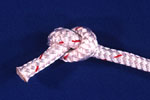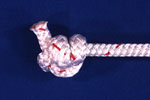
| Square (reef) knot. One of the best known knots for tying together two lines of equal diameter. Notice the symmetry--both free ends are on the same side of knot. It's a relatively
weak knot--breaking strength is only 45% of rated line strength. It should not be used where lines will be under strong tension, as it has a tendency to slip. For high-tension knots, the sheet bend, surgeon's knot, or fisherman's knot are recommended (see below). |

| Thief knot. It resembles the square knot (above), but notice that the two
free ends are on opposite sides of the knot. This knot slips easily; it should be
avoided for kite flying. |

| Granny knot. Similar to the square knot (above), but notice the different overlap
pattern. This knot slips easily; it should be avoided for kite flying. |

|  Sheet bend. An excellent knot for joining two lines of equal or unequal diameter. The knot has moderate strength and is highly resistant to slippage. It is recommended in preference to the square knot. Note both free ends should be on the same side of the knot. Sheet bend. An excellent knot for joining two lines of equal or unequal diameter. The knot has moderate strength and is highly resistant to slippage. It is recommended in preference to the square knot. Note both free ends should be on the same side of the knot. |

| Double sheet (Becket) bend. Like the sheet bend, but with an extra turn around the
standing loop. An excellent means to join slippery lines of unequal diameter. |

| Surgeon's knot. Tied in a manner like the square knot, but with an extra wrap on both sides. This knot has moderate strength and high resistance to slippage. Often used for kite bridles, it is recommended for joining lines of equal diameter. |

| Fisherman's (English) knot. The knot is shown here before tightening. Each line
is tied in an overhand knot around the other line, a simple procedure (see below). |

| Fisherman's (English) knot. This example shows the knot pulled tight. The
fisherman's knot is one of the strongest and most resistant to slippage of all knots
for tying two lines together. |

|  Lark's head (cow hitch). A simple knot created by passing the line through a loop around the anchor. This knot is used to tie a ring into a line (see below). The lark's head is easy to tie, moderately strong and resistant to slippage. It's also quick to untie. Lark's head (cow hitch). A simple knot created by passing the line through a loop around the anchor. This knot is used to tie a ring into a line (see below). The lark's head is easy to tie, moderately strong and resistant to slippage. It's also quick to untie. |

| Lark's head (cow hitch). Place a loop of line through a ring and spread the loop. Next work the loop down around the ring and pull tight to create the lark's head (see above). |

| Cat's paw. This knot is like the lark's head but with an additional twist in the loop,
which gives it more resistance to slippage compared to the lark's head. The cat's paw is a
useful knot, but it's somewhat more difficult to tie. |

| Two half hitches. Half hitches are simple, strong, and easy to tie. The knot has
moderate resistance to slippage. Knot breaking strength is 75% of rated line strength. |

|  Anchor (fisherman's) bend. Two half hitches in which the first half hitch is locked by a round turn. This has become the author's favorite means to attach kite flying line to snaps and rings. Knot breaking strength is 70% of rated line strength. Anchor (fisherman's) bend. Two half hitches in which the first half hitch is locked by a round turn. This has become the author's favorite means to attach kite flying line to snaps and rings. Knot breaking strength is 70% of rated line strength. |

| Clove hitch. A simple knot, but one that is prone to slip with synthetic line on
a smooth anchor. Because the line does not bend back on itself, this hitch is quite strong--breaking strength is 75% of rated line strength. It's also easy to tie. |

| Clove hitch--extended. Additional wraps around the anchor increase the frictional
resistance to slippage. |

| Clove plus two half hitches. This compound knot combines the characteristics of the
clove and half hitch into a knot that is quite strong and highly resistant to slippage. This
combination can be used for attaching the flying line to the kite bridle and for other
critical connections. |

|  Cleat tie down. Proper cleat tie down involves overlapping the line in a figure eight pattern. Note the free end (lower right) is tucked under itself on the final wrap to lock the line. Cleat tie down. Proper cleat tie down involves overlapping the line in a figure eight pattern. Note the free end (lower right) is tucked under itself on the final wrap to lock the line. |

|  Bowline. A strong knot for making a loop that will not slip is the bowline. It's breaking strength is about 60% of the line's rated strength. Bowline. A strong knot for making a loop that will not slip is the bowline. It's breaking strength is about 60% of the line's rated strength. |

| Bowline with two turns. The bowline has many variations. This variant, with an
extra turn, is recommended for slippery kite line. |

| Bowline with a half hitch. Another variation of the bowline in which the free end
is tied in a half hitch to lock the knot. |

| Slip (running) knot. As the name implies this loop is designed to slip tight around
an object. It's an easy way to attach a line to an anchor, but not as strong at the hitches shown above. |

| Fisherman's eye (loop). The eye is shown here before tightening. It's made by tying
two overhand knots around the line, a simple procedure (see below). |

| Fisherman's eye. The knot is shown here after tightening. This loop is strong and
will not slip; it is recommended for kite flying. |

| Alpine butterfly (noose). Here's a quick way to tie a non-slip loop in the middle of a line. It could serve in place of a lark's head and ring for making an attachment point in the middle of a kite flying line. |

| Overhand knot. By far the simplist way to make a stopper at the end of a line. The
small size of the knot limits its function as a stopper, and it is relatively weak--about 45%
of rated line strength. |

| Figure eight (end) knot. A better stopper than the overhand knot, as it makes a larger
mass at the end of a line. The figure eight knot has moderate strength--about 50% of rated line strength. |

|  Stevedore's knot. Similar to the figure eight knot, but with an extra turn. A still better stopper, because of the large mass the knot makes in the line. This stopper is recommended for kite flying. Stevedore's knot. Similar to the figure eight knot, but with an extra turn. A still better stopper, because of the large mass the knot makes in the line. This stopper is recommended for kite flying. |

| Sheep shank. The line is doubled back on itself, then looped over each end of the
doubled section. This is a temporary knot that holds well under tension, but releases
easily when the tension is removed. It is not recommended for conditions of heavy line
stress, as it can pull apart. Knot breaking strength is 45% of rated line strength. |

| Knotted (man o' war) sheep shank. An attractive variation of the sheep shank. The central knot makes this structure more resistant to slippage. |

|  Chain knot. For compact storage of line the chain knot is recommended. It starts with a slip knot (right side); the free end then is pulled through the loop, and the operation is repeated to form the chain. This is a good way to handle the lines of a Picavet suspension for tangle-free storage. Chain knot. For compact storage of line the chain knot is recommended. It starts with a slip knot (right side); the free end then is pulled through the loop, and the operation is repeated to form the chain. This is a good way to handle the lines of a Picavet suspension for tangle-free storage. |

